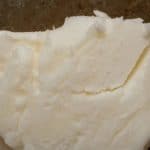Quick summary: Yes, shortening can go bad, although it will last at least six months or more, depending on the storage conditions.
Shortening is a fat that is stable in solid form at room temperature. If you’re like most, you mainly use it to make crumbly pastry and nothing else. There are some other bakery products for which they are used, but this is really not a food that you use in daily meal preparation. That’s why you’re probably wondering how long it can last after opening.
Although it doesn’t have to be, the most famous shortenings are vegetable fats. Even if you were not familiar with this food at the beginning of your culinary career, if you have taken up making pies or pastries more seriously, you will realize that without the addition of this fat, the end result is simply not as good. So here are tips on how to store shortening and how to recognize that it is off.
How Long Does Shortening Last?
The duration will largely depend on the manufacturer itself, that is, the product’s production and packaging method. So always look at what the label says on the back of the package. But some general rules may apply.
Unopened shortening
The product’s shelf life from different manufacturers varies from eight months to two years. It really depends on how it’s produced, how many additives and preservatives it has, and ultimately how it’s packaged. However, you can count on a minimum of half a year if it is stored unopened under favorable conditions. Keep in mind that any dates written on the label do not guarantee the quality if you keep the shortening in too hot conditions.
Opened shortening
After opening, the shelf life shortens significantly, and you are most likely looking at about three months of good quality. It may last a little longer, but really pay attention to possible signs of deterioration. You want to avoid taking any chances with rancid fat.
Can Shortening Go Bad?
Yes, shortening can go bad, and it can definitely give you food poisoning or some other health consequences if you consume it that way. It is better to be safe and look out for signs that the product has expired.
Sign 1: Smell is off
Shortening, just like most other fats, will become rancid over time. You should be able to smell it clearly. And if you are wondering whether you can still use such a product because it will still be baked, the answer is no. You will only ruin your hard work because rancid shortening will surely destroy the end product and possibly cause you health problems.
Sign 2: Mold appeared
Yes, mold can grow on shortening, and you want to avoid using such a product. If you notice any organic growth on the surface or it just looks suspicious, throw everything in the trash.
Sign 3: Color has changed
The shortening has a lovely white color, and any deviation from this means that it is spoiled. If you notice a yellowish tint or any darker spots, it’s trash time.
Which is the Best Way to Store Shortening?
Storage conditions are of crucial importance for the durability of shortening. This is a relatively long-lasting but still delicate product, and you must ensure a minimum of environmental conditions to ensure that it is suitable for eating.
Tip 1: Keep at a cool temperature
The shortening should be at a comfortable cooler temperature away from light. This can mean a pantry if you have one. But if it’s at least a little warmer in your kitchen, be sure to put the product in the refrigerator to make sure it stays fresh.
Tip 2: Seal well after use
Always close the container tightly after taking the required amount. If it is open, certain kitchen pests could find their way into the shortening. But also, the air and possible environmental microbes will surely favor spoilage. We must mention that a can is not a good choice for storing food after opening, so if you have shortening packaged like that, consider transferring the leftovers to a more acceptable container.
Tip 3: Freeze for longer storage
If you know you won’t need the leftover shortening so soon, it would be best to freeze it and save it for later. You can immediately distribute the quantities according to the necessary portions and take out only as much as you need for the cake.
FAQs
The rancid smell should be clearly present as soon as you open the lid. Also, any color changes are a sign of spoilage, as well as the presence of mold or pests.
It depends on the manufacturer, but you can generally count on quality up to three months after opening.
Yes, spoiled shortening can give you food poisoning. Some doctors state that rancid fats can harm health in the long run, so you should throw away the bad product.
Conclusion
Shortening is an ingredient that is rarely used, probably only when making crumbly cakes, and that’s why it often happens that you have leftovers sitting in the kitchen for a long time. The good thing is that you can always freeze a certain amount and save it for later. Pay attention to signs of spoilage, as expired shortening will not be good for your health.
If your shortening is already spoiled, you might want to use these shortening substitutes.
*image by bhofack2/depositphotos









